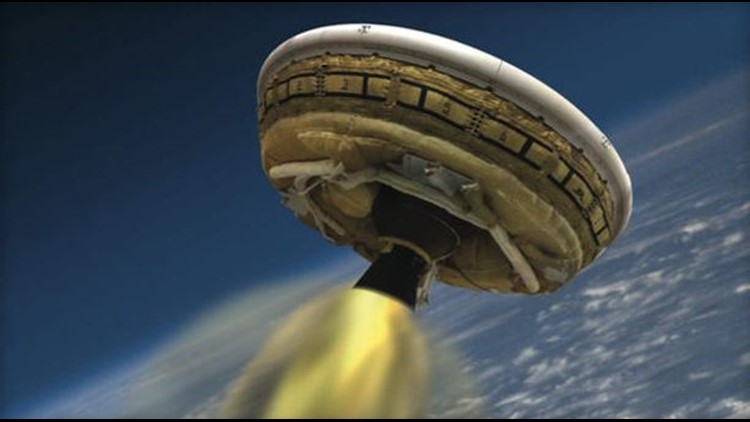CBSNEWS - A giant high-altitude balloon loaded with 34 million cubic feet of helium gracefully ascended into the sky above Hawaii Monday, carrying an experimental 7,000-pound flying saucer-like craft to the edge of space to test an inflatable airbrake and a huge supersonic parachute needed to land heavy payloads on Mars.
Making the second of three flights planned in a $230 million test program, the Low-Density Supersonic Decelerator, or LDSD, test vehicle got off the ground at 1:45 p.m. EDT (GMT-4), kicking off a slow climb away from the U.S. Navy's Pacific Missile Range Facility on Kauai, Hawaii.
After reaching an altitude of 120,000 feet, about 22.7 miles above the Pacific Ocean, the flight plan called for the LDSD to be released for a short free fall. Seconds later, the vehicle's Star 48 solid-fuel rocket motor was scheduled to fire for 71 seconds, boosting the craft to an altitude of about 180,000 feet, or 34 miles.
At that altitude, traveling at a velocity of about four times the speed of sound, the craft will experience aerodynamic conditions similar to what a Mars lander would encounter during a descent to the red planet's surface.
The heaviest spacecraft ever sent to the surface of Mars, NASA's Curiosity rover, had a landing weight of about one ton. To get heavier robots to the surface, and eventual crewed spacecraft that could weigh 20 tons or more, NASA must develop better braking systems to help slow incoming spacecraft in the thin martian atmosphere.
The Low-Density Supersonic Decelerator features two new technologies to do just that.
The first is an inflatable Kevlar torus around the perimeter of a traditional heat shield, known as the Supersonic Inflatable Aerodynamic Decelerator, or SIAD, that gives the test vehicle the general shape of a flying saucer. Once inflated, the SIAD will increase the cross section of the spacecraft from 15 feet 5 inches to about 20 feet across, increasing atmospheric drag.
The second new technology is a huge 100-foot-wide "ringsail" parachute, the largest ever designed to deploy at more than twice the speed of sound.
After the rocket motor boosted the test vehicle to a velocity of about Mach 4, the craft was expected to slow on its own to around Mach 3. At that point, the SIAD could be inflated, slowing the craft down to around Mach 2.4. The flight plan called for the parachute to deploy a few moments later.
Test duration, from parachute drop to splashdown was about 42 minutes.
During the program's initial test flight last year, the SIAD worked flawlessly but the parachute ripped apart in the supersonic airflow. Studying high-resolution video of the inflation process, "we saw things that we had never seen or imagined before," said Ian Clark, the LDSD principal investigator at NASA's Jet Propulsion Laboratory.
"We saw a much more dynamic and much more turbulent parachute inflation than we had ever known," he said. "We saw things like the suspension lines exploding like lightning and moving in a chaotic manner all over the place."
After a detailed analysis of the data, engineers have "a much better understanding of the physical processes that govern and dominate how these parachutes behave under these 2,000-mph winds," Clark said.
"We have made a number of improvements to our parachute," he told reporters. "We've got more curvature to the geometry that helps reduce stresses early on in the inflation process, we've added a lot more structural high-strength material in the crown of the parachute, throughout the parachute, to make it more robust through a lot of the dynamics we saw in the inflation process."
The resulting parachute is "a much stronger, more robust parachute that we think is going to provide us with another tremendous data set for us."
It's not yet known when the technology might be used on an actual flight to Mars, but Clark told reporters before the first flight last year that it will definitely be needed at some point.
"Landing on Mars is an extremely challenging thing to do," he said. "The atmosphere is extremely thin, it's about 1 percent the density of Earth's atmosphere. That means you need very large devices to react against the atmosphere to create the drag that we use to slow the vehicles down as they enter the atmosphere.
"If you want to land things that are even heavier than the Mars Science Laboratory, if you want to land several tons -- and as you cast your eyes to the horizon and you think about landing humans on the surface of Mars, missions that will be 10 to 15 tons, 20 tons or more -- you're going to need extremely large drag devices to slow those vehicles down. We don't have those currently, and that's what LDSD is developing."
A larger test craft, with an inflated diameter of 26 feet, is scheduled for launch next year.



